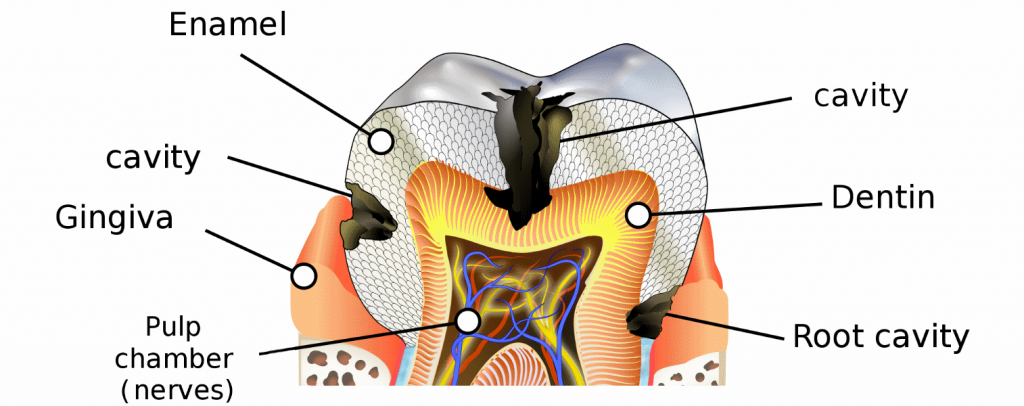Cavities and Tooth Decay
Tooth decay, to some degree, is inevitable. Teeth age over time, regardless of how diligent you are in your cleaning regimen. Deep grooves, pits, and fissures in the top of the teeth collect bacteria that begin the decay process. Hard-to-reach areas between the teeth can only be cleaned with floss.
Due to its warm moist interior, the mouth is an ideal living environment for bacterial microbes. These microbes are responsible for most tooth damage, and they thrive on sugar. By limiting your sugar intake and brushing and flossing daily, you give your teeth their best chance of staying free of decay.
It is also very important that you visit your dentist every six months to have your teeth cleaned and inspected. Early stages of tooth decay are, in most cases, quite painless. Only a professionally trained eye can spot and eradicate tooth decay.
The location and extent of the decay in a tooth will determine how the tooth can be restored. Decayed areas of the teeth can be restored in several ways today.
If you are due for your six-month checkup, you should schedule an appointment with your dentist.
Where cavities most often form

There are two common areas where cavities are most likely to form:
Back teeth – These are the most susceptible to decay because they are most often used when chewing food, and they have small fissures and grooves which are sometimes impossible to keep clean.
Proximal surfaces (between the teeth) – The areas between your teeth are susceptible to tooth decay because brushing, even after every meal, is not sufficient to clean between the teeth. It is important to include flossing in your daily routine to ensure that you keep these areas relatively free of plaque and tartar.
If you would like more information on how to floss properly or are due for your six-month checkup, you should schedule an appointment with your dentist.
Stages of tooth decay
Decay of the enamel
Tooth decay is a process that occurs gradually over time. It ordinarily begins at the outer layer of enamel where plaque has formed. Because enamel is almost entirely made up of minerals and has no live cells or nerves, this stage is usually painless and often goes unnoticed.
Decay of the dentin
The decay then penetrates the dentin. The dentin is made up of both minerals and living cells. These cells are connected to the nerve cells in the pulp. A person may begin to notice increased sensitivity or even some pain, although this stage can also go unnoticed.
Since decay spreads faster in the dentin, the softer tissue becomes affected and cannot support the enamel. At this stage, the tooth may break and cavities can form.
Decay of the pulp and pulp death
Next, the pulp (the center tissue of the tooth) becomes inflamed. Left untreated, the decay will reach into the pulp, which contains pain-sensitive nerve endings. The tooth will most likely ache. This condition requires dental assistance or the tooth may die.
Abscess Formation
Infection-causing bacteria form an abscess, which can spread bacteria to adjoining teeth or other parts of the body. Caught early enough, the tooth can usually be saved by a root canal procedure. If the tooth cannot be saved, it will have to be extracted.
Because the early stages of tooth decay are relatively painless and often go unnoticed, it is extremely important that you schedule an appointment for a dental checkup and cleaning every six months.
